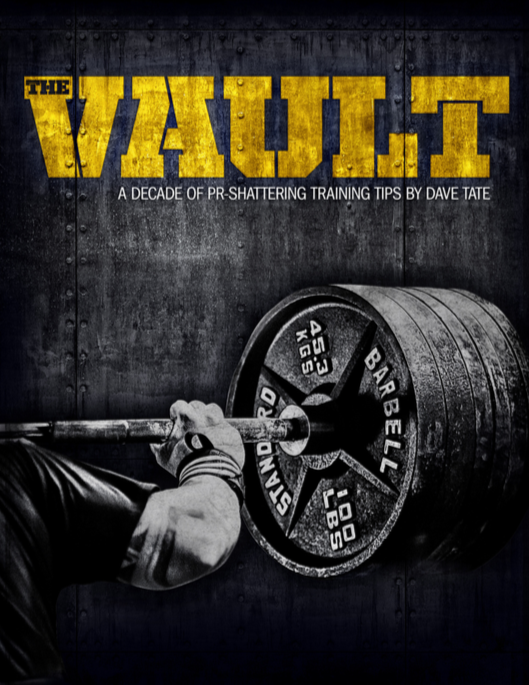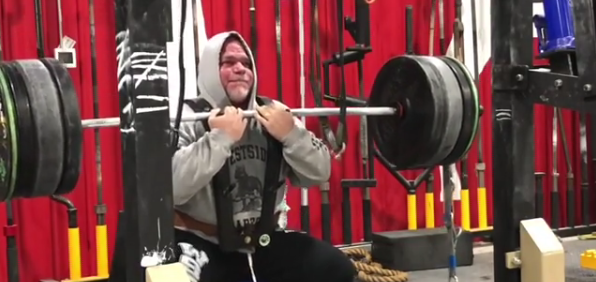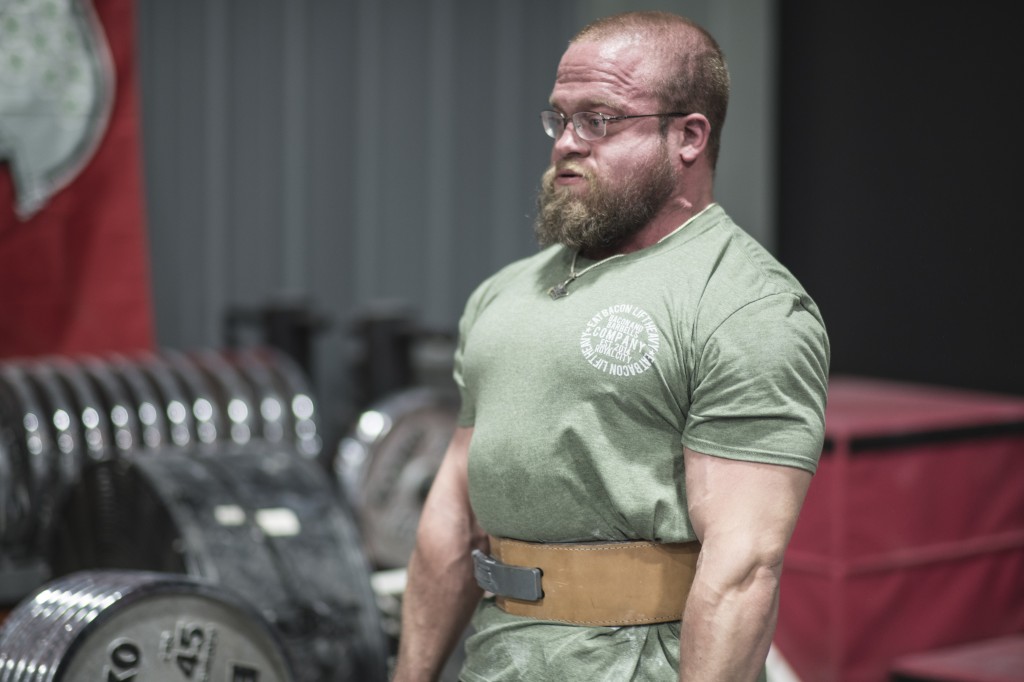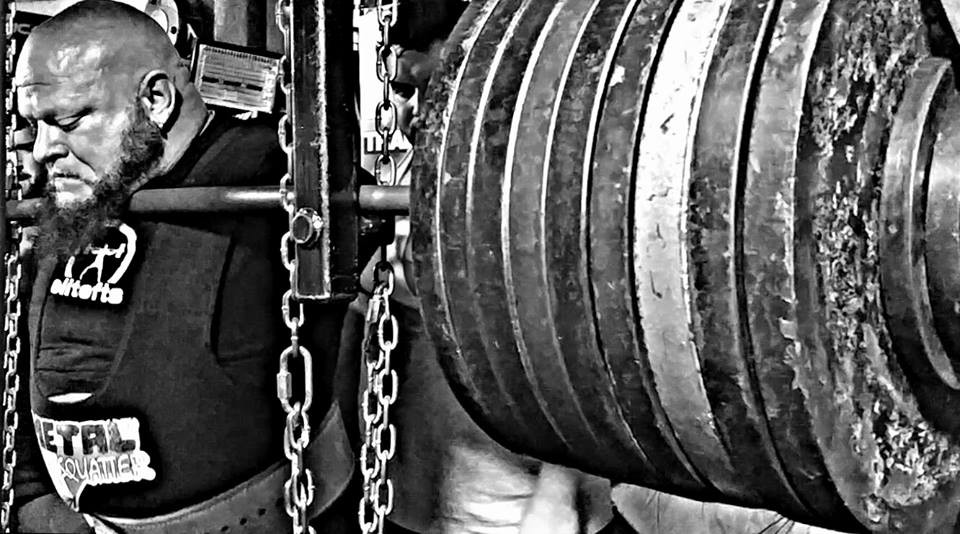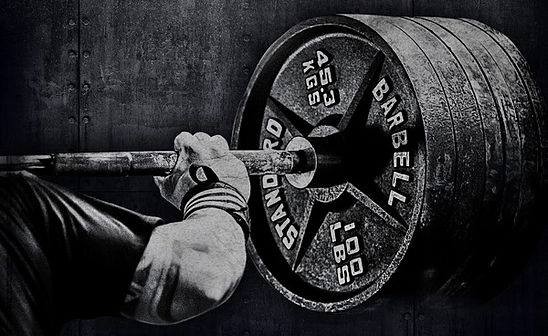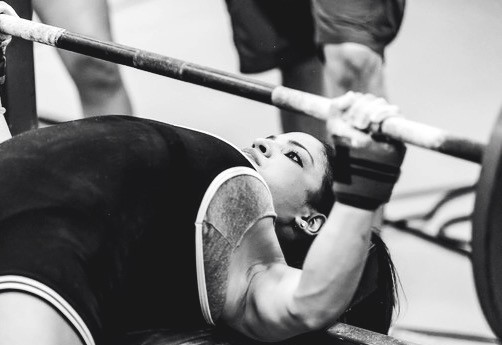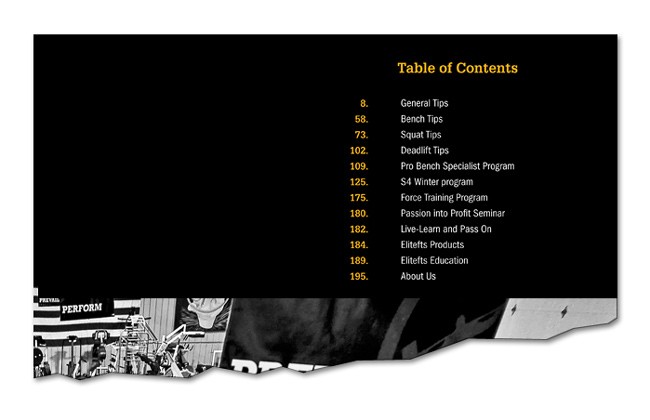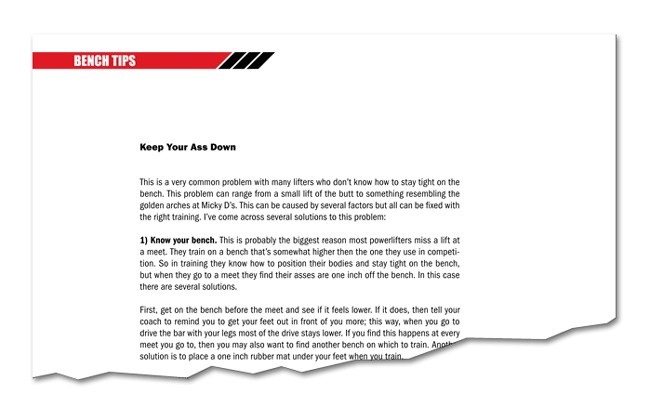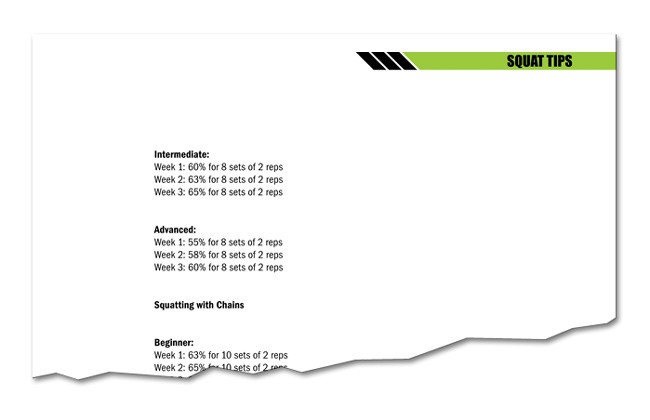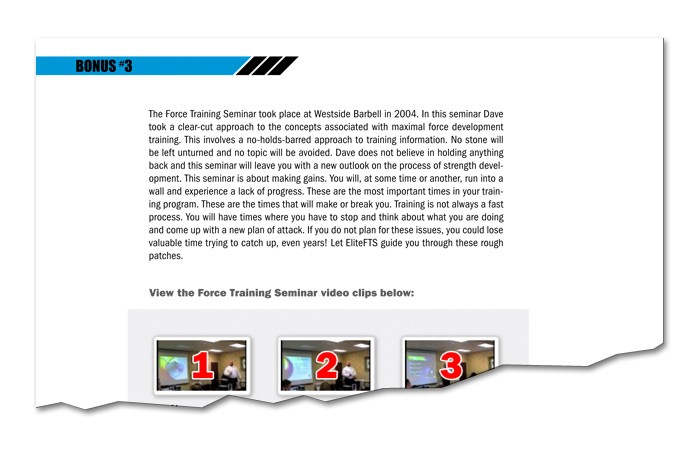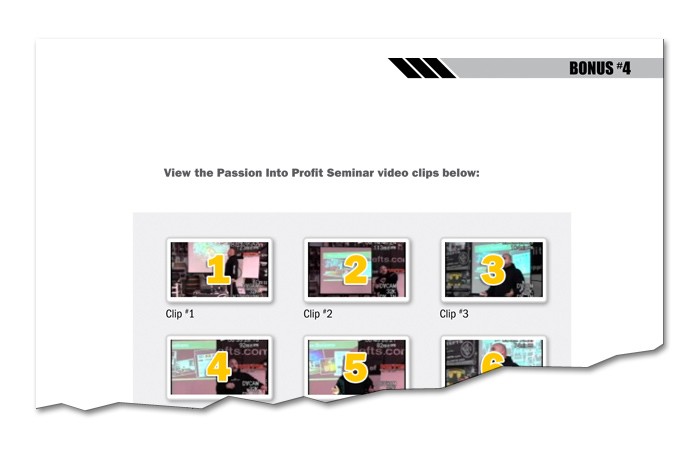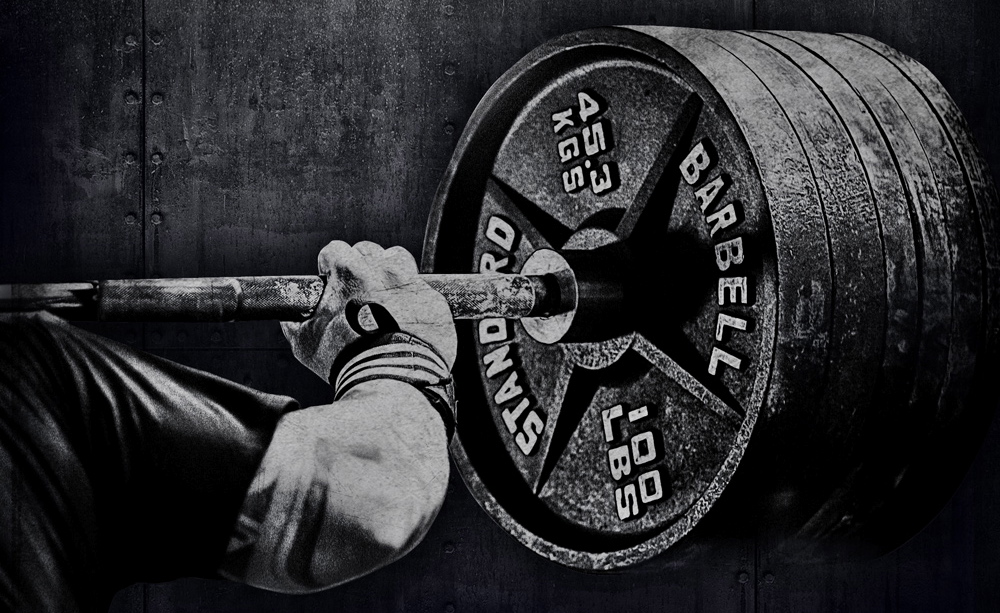
This excerpt is from THE VAULT.
Dave Tate is giving everything away.
Click Image To Download
EliteFTS has been in business since 1998. What, in that time, have you missed? What have you forgotten? What, in nearly 21 years of offering the best training information in the history of the world, can we tell you that will make you stronger?
EXCERPT
Do the Stuff You Suck At
Do you ever wonder where your weak points come from? They're a combination of your strengths overpowering the rest of your skills, and you simply not doing the stuff you hate to do.
Think about it, if your abs and core stability are your weak points, is it because you're training them too hard or too often? Not on your life. Show me a weak point, and I'll show you a movement that isn't being trained because the athlete doesn't like to do it.
Is this something you hate to do? Then do it.
Let me tell you about how I discovered this secret.
It was at the IPA Worlds (a.k.a. the York Barbell Hall of Fame), my first meet after a nine-month hiatus. I had taken some time off to heal up, regroup, and push my bodyweight up higher. I was looking forward to this meet, because my training was going very well, and things seemed to be going my way. My warm-up for the squat attempts felt great, fast and very explosive. I was definitely getting jacked up about the meet.
I was on deck, next up. My wraps were on, tight as hell, and I was ready. The moments right before I hit the chalk are the best moments of my life. The anticipation, the aggression, the work it took to get to this moment are unmatched.
Finally, over the loudspeaker came the words I'd waited nine months to hear, "Load the bar to 860 pounds for Dave Tate." It was a weight I'd squatted several times before, and it was to be my opening attempt. Full of rage, I began chalking my hands.
This is the moment with every big lift that I "detach" from myself, and go on autopilot. Rarely do I remember anything from the time I leave the chalk box until after the lift.
However, this lift I do remember, because I couldn't get it out of the rack.
I remember trying to stand up with the weight, but I couldn't budge it. It felt welded to the rack. I tried a few times and still nothing. This pissed me off to no end, so I stepped back and increased my rage as high as I could, got back under the rack...and nothing.
My helpers stepped in and pulled me from the rack. Needless to say, this was not a good moment for me. Nine months of training and I couldn't get my damn opener out of the rack.
Just then, I heard Louie call out, "Dave, you're done. Pull out." I glanced back at him, figuring he was just trying to piss me off. But he looked straight at me and said, "I'm serious, Dave. You're done. Pull out, and we'll talk later. It's not worth what could happen right now."
Now, Louie is one of the best coaches in the world, and I was part of his team, the WSBB. This club is known to be the strongest gym in the world and I was one of Louie's boys.
So I pulled out, and spent the rest of the meet watching the rest of my team lift well, sitting there eating hot dogs and wondering what the hell my problem was.
On the drive home, I told Louie, "I don't understand what happened today. My training went well. I was strong as hell on everything in the gym."
Just then he stopped me and said something I'll never forget: "That's exactly your problem."
As we turned onto the Interstate, I sat there thinking that Louie was out of his mind. How could being strong in the gym be a bad thing?
How can being strong as hell in the gym be a bad thing?
"You know what you need, Dave?" Louie continued. "You need to do those things you suck at. You're at a point where your weaknesses are killing you, and you're doing nothing to address them. Your legs and upper back can easily squat a grand, but your abs and lower back can't squat 860 pounds. Which do you think you'll squat, 1000 or 860?
The simple truth hit me like a half-ton of iron. Louie was exactly right. In training, I hated doing reverse hypers and standing ab work. As a matter of fact, I hated all lower back and ab work, so to be honest, I skipped it most of the time.
Once again: your weak points are caused by doing what you hate to do. And this is the difference between competitive athletics and "working out." You can always get into better shape by doing things that you like to do, but to excel at a sport, you have to master doing the things that you hate to do.
So, for the next six months I trained my lower back and abs four days a week: once at the beginning of every session, and at the end of each session. At the Nationals in November, I squatted 900 pounds for the first time. For the next meet, I increased my torso training to six days a week, with three days being very heavy and three days being light.
In July, I went back to the IPA Worlds, the same meet I had to pull out of the year before. I squatted 860 pounds, then 905 pounds, and onto an easy 935 pounds.
While training for the 935 pounds, my main gym lifts that I had bragged were so strong were actually down 15 percent from the previous year, however, my torso strength was the strongest that it had ever been.
Rounding the lower back when deadlifting
This is another mistake I see all the time and most lifters know better. It happens most of the time because of a weak lower back or a bad start position. While keeping your shoulders rounded you must keep your lower back arched. This will keep the shin straight and the shoulders behind the bar and keep your body in the proper position to pull big while keeping the back under minimal stress.
If you pull with a rounded back, the bar is going to drift forward away from the legs, thus putting you back into a very difficult position from which to recover. When the bar drifts forward, the weight of it will begin to work against your leverages and cause you to have a sticking point just below the knees or mid-shin level. When you pull you can either arch your back in the beginning standing position before you crouch down to pull or once you grab the bar. Either way it's important to keep the lower back arched and tight.
There are many ways to strengthen the lower back for this. Good mornings, reverse hypers, and arched back good mornings are a few. You can also use a band around your traps and feet for simulated good mornings. With this technique you only use the bands and train for higher reps (in the 20 to 30 rep range) for local muscular endurance.
Falling forward halfway up in the squat
This is probably the second most common problem or sticking point I see with the squat. What happens here is the lifter comes out of the hole strong and then about halfway up he begins to fall forward. This happens because he has great reversal strength out of the bottom but then, as he begins to hit the mid-point, he stalls. He can’t continue to strain because the torso is beginning to die out and the force of the movement keeps the hips coming up, yet the upper body can’t stay upright.
To fix this he needs to make sure the time-under-tension on the max effort movement is specific to the time of the strain needed in competition. This will be around 3.0 to 4.0 seconds. Second, the ab work has to come up and be heavy. A third remedy for this problem is to do static work in the position at which you lose the lift. To do this, use a bar with a light weight (around 20%) and a band. Squat down to the spot you lose it at and hold for five seconds, then squat back up and hold at the top for five seconds. This would best be done with 3 to 5 sets of 5 reps. The good morning can also be used for this and may even be a better choice as there'll be more work on the torso when compared to the barbell squat.
One last solution for this problem is to use the safety squat bar for max effort work. The safety squat bar tries to toss you forward as you squat up because of the design of the bar. If the bar is trying to toss you forward, there's only one way to keep this from happening: you have to fight to keep the bar in position, thus developing those muscles.
Falling backwards in the squat
This is actually the best thing that could happen because you're squatting the bar back and all the strength is there. The only thing that really needs to be done here is technical. Just sit back more to allow the torso to lean in some. The lifter may also not be sitting back because of weakness in the hamstrings.
Knees coming in while squatting down: This is also a very common problem with beginners and intermediate lifters. This can happen for many reasons: weak hips, poor flexibility, or bad form. If the lifter has bad form all he needs is verbal queues of "Knees out!"
If this is a flexibility problem then the lifter should squat on a higher box at the point where he can keep the knees out. Over time the box height will come down as he gets more flexible. If this is a strength problem with the hips, then the same solutions as "getting smashed at the bottom" should be followed.
Lockout Strength
This is really one of the best problems to have and the easiest to fix. When you’re dealing with sticking points in the bench press you have to remember that there are several ways to correct the problem, but most won’t work for you. So don’t beat a dead horse! In other words, if what you’ve been doing isn’t working, then try something else. You have plenty of ammo. I’ve had this same problem with my bench and sometimes it takes years to stumble upon the right movement to fix the problem. Other times I hit the right movement the first time out.
1) Get your head right. This is true with all sticking points regardless of the point at which you stall out. If you believe you always miss at the top, then you’ll always miss at the top! Your mind has a lot to do with your sticking points. I try to teach all the athletes I work with to visualize their sticking point at a higher position and focus very hard on driving the bar through it. In other words, when you bench you must focus on pushing the bar very fast through your sticking point. Focus will make a big difference.
2) Learn to use your triceps. This is done by keeping your body tight and focusing on pulling the bar apart. This will involve your triceps more throughout the movement and keep the bar moving in a straight line. A good trick to teach you to do this is to use a elitefts mini band. You double the band up and wrap it around you wrists while you bench. This forces you to pull the bar apart and grasp the barbell tight. If not, your hands will be shot together. Pull the bar apart and watch that sticking point disappear!
3) Start the bar where you want to finish. This is a very simple concept but it’s very seldom practiced. Most lifters will unrack the bar and lower it to the chest without setting the bar first. This is usually done by habit and will cause you to lower the bar in a diagonal pattern that will result in you pushing it back up in the same pattern. When you push the bar back toward the rack there’s more rotation and less emphasis on the triceps.
You need to unrack the bar, then "set it" in the same exact position in which you want to finish. This should be directly above where you lower the bar. If you bench to your lower pecs then the bar must start above the lower pecs. This will create a straight line both on the eccentric and concentric. Remember, the shortest distance between two points in a straight line.
4) Move the bar fast. You need to make sure you’re pressing as fast as possible to bust through your sticking point. A slow press won’t build enough momentum to bust past your sticking point. If you’re trying to open a stuck door would you try to open it slowly or would you bust into it as hard as possible? Speed is key!
5) Strengthen the top half. There are several movements that can help you strengthen the muscles that lockout the bench. These are best done using the max effort method. This is the method where you work up to a one or three-rep max on the movement.
The best movement for a weak lockout is a three or four board press. A board press is preformed by using three or four 2 x 6 boards placed on your chest. Lower the bar to the boards, pause and press back up. In extreme cases you may want to use a set of mini bands on the bar as well.
A second movement that works very well is the floor press with the use of chains. The floor press is performed the same as the bench press except you’re lying on the floor. Work up to about 60 to 70% of your best bench, then begin adding one set of chains on the bar with each additional set. You fail when you can no longer add any more chains.
This excerpt is from THE VAULT.
Dave Tate is giving everything away.
Step up and take it.
EliteFTS has been in business since 1998. What, in that time, have you missed? What have you forgotten? What, in nearly 21 years of offering the best training information in the history of the world, can we tell you that will make you stronger?
What’s in The Vault?
200 pages of Dave’s best training information, including a ton of unpublished material.
Bench, Squat, Dead Lift plus hundreds of other Training Tips.
Training Cycles and Plans from the beginner to advanced lifter.
The complete Force Training Seminar – over 6 hours of video!
Dave’s Passion to Profits Seminar – over one hour of video.
Complete and Full Training Programs for:
* A full bench specialist program
* A complete meet-prep program for the squat, bench, and deadlift that resulted in an EFS lifter adding 230 pounds to his total.
* Plus much more, over 200 pages of it!
For more information
Click HERE









